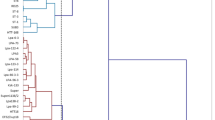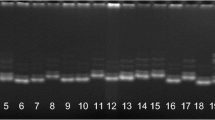Abstract
Molecular markers provide novel tools to differentiate between the various grades of Basmati rice, maintain fair-trade practices and to determine its relationship with other rice groups in Oryza sativa. We have evaluated the genetic diversity and patterns of relationships among the 18 rice genotypes representative of the traditional Basmati, cross-bred Basmati and non-Basmati (indica and japonica) rice varieties using AFLP, ISSR and SSR markers. All the three marker systems generated higher levels of polymorphism and could distinguish between all the 18 rice cultivars. The minimum number of assay-units per system needed to distinguish between all the cultivars was one for AFLP, two for ISSR and five for SSR. A total of 171 (110 polymorphic), 240 (188 polymorphic) and 160 (159 polymorphic) bands were detected using five primer combinations of AFLP, 25 UBC ISSR primers and 30 well distributed, mapped SSR markers, respectively. The salient features of AFLP, ISSR and SSR marker data analyzed using clustering algorithms, principal component analysis, Mantel test and AMOVA analysis are as given below: (i) the two traditional Basmati rice varieties were genetically distinct from indica and japonica rice varieties and invariably formed a separate cluster, (ii) the six Basmati varieties developed from various indica × Basmati rice crosses and backcrosses were grouped variably depending upon the marker system employed; CSR30 and Super being more closer to traditional Basmati followed by HKR228, Kasturi, Pusa Basmati 1 and Sabarmati, (iii) AFLP, ISSR and SSR marker data-sets showed moderate levels of positive correlation (Mantel test, r = 0.42–0.50), and (iv) the partitioning of the variance among and within rice groups (traditional Basmati, cross-bred Basmati, indica and japonica) using AMOVA showed greater variation among than within groups using SSR data-set, while reverse was true for both ISSR and AFLP data-sets. The study emphasizes the need for using a combination of different marker systems for a comprehensive genetic analysis of Basmati rice germplasm. The high-level polymorphism generated by SSR, ISSR and AFLP assays described in this study shall provide novel markers to differentiate between traditional Basmati rice supplies from cheaper cross-bred Basmati and long-grain non-Basmati varieties at commercial level.
Similar content being viewed by others
Abbreviations
- PCR:
-
polymerase chain reaction
- AFLP:
-
amplified restriction fragment polymorphism
- AMOVA:
-
analysis of molecular variance
- Hav:
-
average heterozygosity
- ISSR:
-
inter simple sequence repeats
- EMR:
-
effective multiplex ratiol
- MI:
-
marker index
- PCA:
-
principal component analysis
- PIC:
-
polymorphism information content
- SSR:
-
simple sequence repeat
- TB:
-
traditional Basmati
- UPGMA:
-
un-weighted pair-group method with an arithmetic average
References
Abdalla, O., J.A. Dieseth & R.P. Singh, 1992. Breeding durum wheat at CIMMYT. In: S. Rajaram, E.E. Saari& G.P. Hettel(Eds.), Durum Wheats: Challenges and Opportunities, pp. 1–13. CIMMYT, Ciudad Obregon.
Ali Dib, T., P. Monneveux & J.L. Araus, 1992. Adaptation à la sércheresse et notion d’ideotype chez le blé dur. II. Caractéres physiologiques d’adaptation. Agronomie 12: 381–393.
Austin, R.B., M.A. Ford, J.A. Edrich & R.D. Blackwell, 1977. The nitrogen economy of winter wheat. J Agric Sci Camb 88: 159–167.
Blum, A., G. Golan, J. Mayer, B. Sinmena, L. Shpiler & J. Burra, 1989. The drought response of landraces of wheat from the northern Negev Desert in Israel. Euphytica 43: 87–96.
Blum, A., B. Sinmena, G. Golan & J. Mayer, 1987. The grain quality of landraces of wheat as compared with modern cultivars. Plant Breed 99: 226–233.
Bozzini, A., D. Bagnara, C. Mosconi, L. Rossi & G.T. Scarascia-Mugnozza, 1973. Trends and results of durum wheat mutation at G.T.Scarascia-Mugnozza(Ed.), Proceedings, Symposium on ‘Genetics and Breeding of Durum Wheat’, Bari, Italy, pp. 339–347.
Bozzini, A. & G.T. Scarascia-Mugnozza, 1967. A dominant short-straw mutation induced by thermal neutrons in durum wheat. Wheat Inform Serv 23–24: 5–6.
Clarke, J., B. Marchylo, M. Kovacs, J. Noll & T. McCaig, 1996. Screening of durum wheats for pasta quality: The Canadian system. In: Proceedings of the 5th International Wheat Conference’, Ankara. Abstract, pp. 233–234.
Cubadda, R. & M. Carcea, 1994. Evaluation of gluten strength in durum wheat and semolina by rapid methods. Italian Food Beverage Technol IV: 15–20.
D’Egidio, M.G., B.M. Mariani, S. Nardi, P. Novaro & R. Cubadda, 1990. Chemical and technological variables and their relationships: A predictive equation for pasta cooking quality. Cereal Chem 67: 275–281.
De Cillis, E., 1927. I grani d’Italia. Tipografia della Camera dei Deputati, Roma, p. 173.
Evans, L.T., 1993. Processes, genes and yield potential. In: D.R. Buxton, R.Shibles R.A. Forsberg B.L.Blad, K.H. Asay G.M.Paulsen & R.F.Wilson(Eds.), International Crop Science I, CSSA, pp. 687–696.
Feil, B., 1992. Breeding progress in small grain cereals. A comparison of old and modern cultivars. Plant Breed 108: 1–11.
Gale, M.D. & S. Youssefian, 1985. Dwarfing genes in wheat. Plant Breed, 1–36.
Grignac, P., 1965. Contribution à l’étude de Triticum durum Desf. Thése doctorat, Toulouse, p. 151.
Kirby, E.J.M., 1988. Analysis of leaf, stem and ear growth in wheat from terminal spikelet stage to anthesis. Field Crops Res 18: 127–140.
Koc, M., C. Barutcular & N. Zencirci, 2000. Grain protein and grain yield of durum wheats from south-eastern Anatolia, Turkey. Aust J Agric Res 51: 665–671.
Kramer, T., 1979. Environmental and genetic variation for protein content in winter wheat (Triticum aestivum L.). Euphytica 28: 209–218.
McNeal, F.H., M.A. Berg, P.L. Brown & C.F. Maguire, 1971. Productivity and quality response of five spring wheat genotypes, T. aestivum L., to nitrogen fertilizer. Agron J 58: 605–608.
Mi, G., L. Tang, F. Zhang & J. Zhang, 2000. Is nitrogen uptake after anthesis in wheat regulated by sink size? Field Crops Res 68: 183–190.
Milach, S.C.K. & L.C. Federizzi, 2001. Dwarfing genes in plant improvement. Adv Agron 73: 35–63.
Nachit, M.M., 1992. Durum breeding for Mediterranean drylands of north Africa and west Asia. In: S. Rajaram, E.E.Saari & G.P. Hettel(Eds.), Durum Wheats: Challenges and Opportunities, pp. 14–27, CIMMYT Mexico, Ciudad Obregon.
Quinn, G.P. & M.J. Keough, 2002. Experimental Design and Data Analysis for Biologists. Cambridge University Press, Cambridge, UK.
Author information
Authors and Affiliations
Corresponding author
Additional information
The first two authors have equal contribution
Rights and permissions
About this article
Cite this article
Saini, N., Jain, N., Jain, S. et al. Assessment of genetic diversity within and among Basmati and non-Basmati rice varieties using AFLP, ISSR and SSR markers. Euphytica 140, 133–146 (2004). https://doi.org/10.1007/s10681-004-2510-y
Received:
Accepted:
Issue Date:
DOI: https://doi.org/10.1007/s10681-004-2510-y




